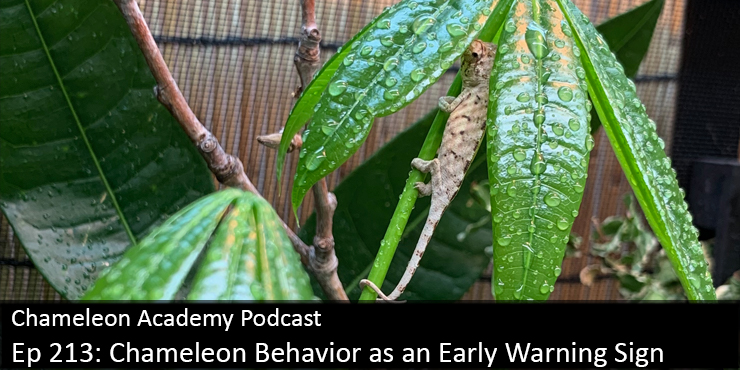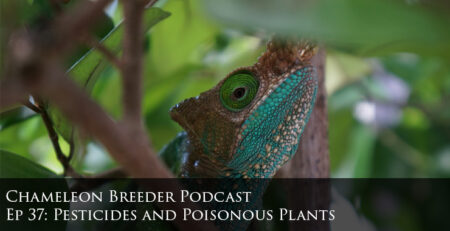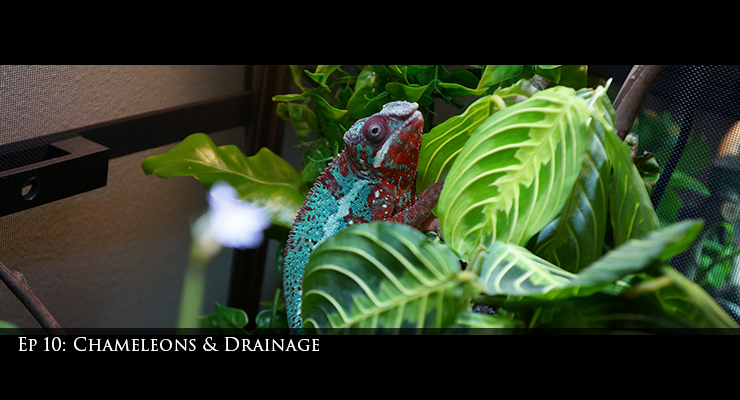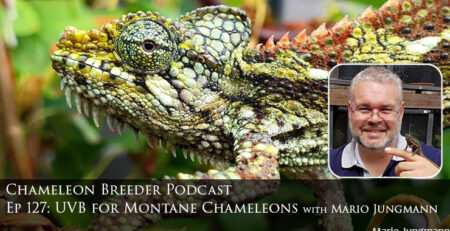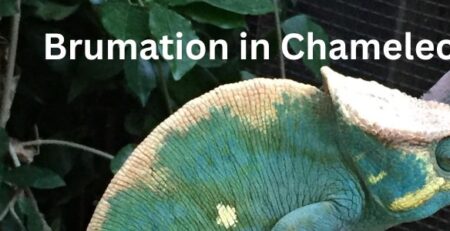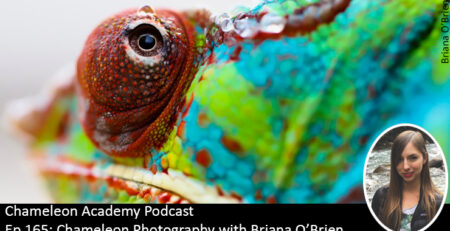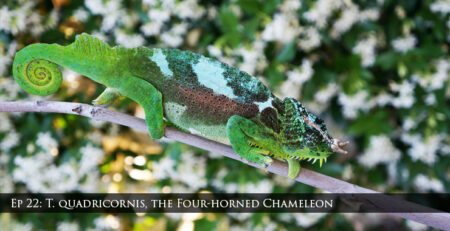Ep 213: Chameleon Behaviors as an Early Warning
Listen Here!


Bill Strand
Chameleon Behavior as an Early Warning Sign
Chameleons have cryptic ways about them. And being mysterious is how they survive. But being cryptic and mysterious also hides illness and that is what we chameleon keepers want to know about right away! Today I talk about the subtle first behavioral warning signs of illness in chameleons.
Links from the episode
I am now doing a second podcast called the Reptile Entrepreneur. If you have ever thought about starting a business in the reptile community then this is the show for you. I go over everything from manufacturing to breeding and various business topics. So far, I have talked to Josh Dovenbarger who is a bearded dragon breeder and David Brahms who makes perches for the Green Tree Python community with 3D printing technology. You are probably familiar with Todd Goode who came on and talked about overseas manufacturing. Next Monday you’ll hear from Richard Clarke who is a patent attorney who gives us an introduction to how the patent process works. And soon I’ll be talking about starting a YouTube channel or even a podcast of your own. If you would like to be more deeply involved in the reptile community then I invite you to check out the Reptile Entrepreneur on any podcast app, YouTube, or, best of all, at reptileentrepreneur.com which will have links to everything!
Transcript (More or Less)
Introduction
Good morning, Chameleon Wranglers! Oh, our chameleons can be tricky beasts to understand. And that is what we chameleon keepers strive to do better and better every day. And more than just an art that we hone, learning our chameleon’s ways to a deep level helps us keep our friends as healthy as possible. Because, the first sign of a health issue with a chameleon is usually a change in behavior.
Some of the most common ailments for chameleons start on the inside and the only way we can detect what is going on, outside of doing blood and fecal tests, is by micro-changes in behavior. Yes, they soon become obvious changes in behavior that unmistakably show a sick chameleon. But by this time it is late in the game. We don’t give up on them and they can be brought back, but if you can detect a growing problem before it becomes a big problem the chances are much greater for success. This is why developing a skill in understanding chameleon body language is so important. But detecting that change in behavior is complicated by two major problems. 1) the chameleon naturally hides any sign of weakness and 2) chameleon behavior is a language all its own which is counterintuitive for human beings and needs to be learned!
Today’s episode is the start of a number of episodes where I am going to lead you through a checklist of items and tests that can help you determine if there is something wrong with your chameleon as early in the game as possible. I will start by going over what is considered normal behavior through out the chameleon’s day and point out different spots where behaviors of concern could show itself. The topic of chameleon behavior and health is a huge one and an important study since chameleons are so good at hiding signs of weakness. Today I’d like to start with the most challenging situation. That is when you are seeing behavioral signs of lethargy or eyes closed. These are signs something is going on, but aren’t necessarily the problem itself. So you have this limbo period where you know something is off, but you have to dig deeper to figure out what. To be sure, more symptoms are coming, but we would rather nip it in the bud before those symptoms of furthering development of sickness show up. So this episode is about that early stage where you have only subtle clues and no hard evidence.
I just need to warn you that interpreting chameleon behavior quickly becomes an art where you having a “feeling” that something is off is enough for you to take action. It starts off with big behaviors that are easy to recognize. As you get better at it and more in-tune with your specific chameleon you need to become more sensitive to your feelings. Because the things that are “off” will be difficult to put a finger on, but you just can’t shake the feeling that something is off. That is what will happen over the years. The longer you are at it the more often your feelings will be correct. How long that takes depends on how attentive you are to your chameleon and how much you are able to put aside the natural human part of you that interprets your chameleon through the filter of what we intrinsically grew up with in human behavior. It just takes time and practice. This episode should get you off to a good start. Know that this podcast is also supported by a whole section on the chameleonacademy.com website. There is an entire page filled with each behavior and some information on that behavior. Your next stop after listening here is to check out the behavior page.
The first thing we need to do before there is any trouble is establish a base line for what a chameleon should be doing and what normal behavior consists of. If this is your first chameleon then you are starting from scratch. So, let’s start at the beginning. Generally speaking…and I say generally because every chameleon will have variations on this depending on personality and their external environment that they are working within. But we have to start with a baseline. A basic day in a chameleon’s life is to wake up and look for the first sun rays to warm up from the cool night. The cool night was important for their body to rest and now they want to bask until their body temperature rises to normal operating temperature. Eyes open upon first light and they make their way to where they think a warm spot is. They will come with dark colors to soak up as much of the warmth as possible and may flatten their body to increase the amount of surface area the light hits.
And here is where we do our first test. Does the chameleon open his eyes when the light comes on? This will be a common theme with chameleons. The eyes are the #1 communicator of chameleon health. While the light is on they should be open and alert. Deep in their DNA they know that eyes open and alert is the way to stay alive. They are always looking for predators and being hatched in captivity does not change this. Looking out for predators is instinct, not learned behavior. Although they definitely do learn to be more or less scared of people or animals, they always have the “on alert” behavior. Here is also where we run into our first culture shock. A chameleon with its eyes closed while the lights are on is either sick or has given up and is waiting for death. Humans, dogs, and cats close their eyes when they are napping during the day or when they are content. When you feel safe you close your eyes and embrace your loved one. Our hearts melt when our puppy feels so safe on our arms that he curls up and closes his eyes. That is the ultimate trust and many of us have the very good policy that if a puppy curls up in your lap and closes its eyes that you are now excused from getting up and doing anything else until that puppy wakes up. So, we come to chameleons with this in our background and totally misread the signs. A chameleon does not snuggle up or nap. A healthy chameleon will never close its eyes around you. Isn’t it suspicious that all of these chameleon whisperers that have a special bond with their chameleon somehow extract dog and human-like behaviors from their chameleons? Chameleons are not pack animals and have had no need or pressure or benefit to develop behaviors that endear them to each other….or us. So, either chameleons have developed latent behaviors all these eons just waiting to be pulled out when they became pets or else the human mind has interpreted behaviors through a filter that makes it happy. The problem with hanging onto the idea that your chameleon loves you is that you will be misinterpreting the signs and that can lead to the death of your chameleon. A chameleon with its eyes closed is giving you a big red warning sign that something is seriously wrong. So, if the lights come on and your chameleon stays asleep it is a warning sign.
Now, let’s talk about warning signs. When we are monitoring behavior we often pick up on changes that are subtle enough that we aren’t sure if we actually saw something. If your chameleon takes a little longer to open their eyes in the morning it may be the start of something serious. It also may be that they are recovering from something they ate that soured their stomach. They live life in all its variations just like we do. So we are looking for as many pieces of data as we can, but we piece them together to form a course of action. What this means is that your chameleon keeping its eyes closed more than usual one day isn’t a concern until it happens another day and then another. By three days it is time to go to yellow alert. But if the chameleon is acting fine, alert, active, and aggressively hunting through out the rest of the day we keep that concern in the back of our mind and look for other clues. If it is something wrong then another behavior should pop up that shows us the direction whatever is going on will take. Chameleon keeping is a constant watching for clues and putting scenarios together. Most of the time these variations in behavior pop up and then go away before enough behavior data points add up to a vet visit. But you have to be good enough to pick up on these behavior clues so you catch them before a big one hits. Noticing eyes closed, lethargy, and the occasional pop during breathing is well past the time a chameleon keeper should have started the chameleon on antibiotics. Not noticing anything until the chameleon is sitting with nose up in the air, gaping and eyes closed means your chameleon’s chances of survival are diminished. And there is no way around learning the subtleties of chameleon behavior language. It is just a necessary part of what we do.
I am making a big deal about the point where your chameleon wakes up because if there is subtle discomfort starting internally, your chameleon may first show that by waking up more slowly. The next step will be napping during the day, which we know is not napping, but it is dealing with internal distress. Just remember. Eyes open is survival for a chameleon. For them to shut their eyes during the day time means that whatever is going on inside them has more pain and discomfort than the need for survival. But, if there is any disturbance, they will resort right back to that survival instinct and will pretend there is nothing wrong. This is why you can tap the cage and they will pop back to looking healthy. You need to trust what you see when you slowly slip into the room. And just to warn you, if you catch something early enough your chameleon will be able to dedicate the energy to looking healthy and presenting them to the vet may or may not be useful. If you have caught it early enough your chameleon will put on quite a show of strength for the vet which can easily get you sent home with a nothing is wrong note. Here is where it is invaluable to have a relationship with your vet where they know you know what you are talking about and that your analysis can be trusted. We do not want to give antibiotics if we do not need to. But if you have detected something that says we have the start of a respiratory infection then your vet can decide that what you saw before your chameleon was riled up was warning enough that action needs to be taken. And here is where trusting your feelings comes in. If you catch an infection early enough there will be some doubt in your mind as to whether something is really going on. And if you decide to trust that feeling and get your chameleon on antibiotics then you have to run the entire course of medicine and that may knock out the infection right away and you will never see the symptoms getting worse. Which means that the absolute best case scenario is that you never have confirmation that you were right. The only way you can validate a feeling is to not follow the feeling and then see signs of a worsening infection. So, how do you hone your skills if the only way to learn whether you are right or not is to allow your chameleon to get sick?
Well, when you are starting out, you will have many feelings that something is off. As a doting parent, the slightest side eye look and you are on social media asking if your chameleon is dying. In the beginning, I suggest waiting until you have confirmation with another symptom before acting on the feelings. Because, in the beginning, you will have many false alarms as you hone that skill. Over time you will learn what is and isn’t a real case. Once you are to this point that is the time to trust your feelings. I want to caution you, I know it sounds great to think of yourself as being so in-tuned with your chameleon that you what your feelings to be confirmed and will look for evidence to prove it and will ignore evidence that disproves it. That I can do nothing about. That is human nature and you have to be the type of person who isn’t doing this for ego’s sake. Put yourself through rigorous serious training. Be glad of mis-interpretations you do because you will learn from them and that will make you better in your art. Deluding yourself into thinking you are a chameleon whisperer before your time will only slow your progress.
So, say we think our chameleon was a little too slow in waking up or we think we caught him with his eyes closed when we walked into the room. What other things can we use to confirm that this is really something to be concerned about? The first is by looking for more of the same. More time spent with his eyes closed. Maybe it is taking longer and longer for him to wake up or you now notice time during the afternoon that he is sitting with his eyes closed. An increase in time with eyes closed is all you need for confirmation. If you notice a discernable increase in eye closed time then this has graduated from a feeling to having hard evidence. It is time to act.
So, what are the next steps? Behavior is an indication of internal discomfort. If you do not yet have an external sign of what is going on, there are a couple of options to consider
By far, the most common is infection – and this can be bacterial, fungal, viral, or parasitic.
It also could be an obstruction – either egg binding or impaction. Another option could be nutritional, but we often see external indications of these effects. Of course, you can go deeper and deeper into this and add poisoning and other fringe cases. They are rare, but they do happen.
Let’s look at infection. This can be bacterial, fungal, viral, or parasitic. And this is where you need to partner with a vet. A fecal exam is your best indication that there is a parasitic infection. A bacterial infection can start showing itself as a swelling, but one of the most common chameleon ailments, a respiratory infection, starts showing itself as the chameleon with its nose in the air and/or mouth open to breath. What is going on is that the infection is blocking the ability for oxygen to be absorbed in the lungs. The nose up straightens the air tube running from the mouth to the lungs allowing a more direct path for air and the gaping allows more air to be sucked in. You want to catch it before it gets to the point where your chameleon has his nose in the air, gaping, and eyes are sunken in. Unfortunately, there isn’t much that can be done before the nose in the air symptoms to confirm a bacterial infection outside of doing a culture test or checking white blood cell count. Bacterial infections take many forms and can be many places, but if there is no swelling around the mouth or swollen eyes or other external sign, it is most likely in the lungs. That is the one internal organ which has constant contact with the outside world through breathing.
Fungal infections often will show as growths on the skin. And viral infections are tough to diagnose.
Blood tests can help point in a certain direction if you have a vet that knows how to read them for reptiles.
The challenging thing is that all of these very different health issues have completely different cures. And you don’t want to waste time applying a cure to the wrong problem. At best it wastes precious time. At worst it make the problem worse as medicines are a stress on the body. We don’t like giving medicine in a shotgun approach because every medicine needs to be processed by the body. If it is knocking down an infection then there is more good than bad. If there is a viral infection and you give an antibiotic then the medicine will not affect the virus at all and the body will divert resources from the immune system fighting the infection to the liver and kidneys to process the antibiotic. Add to that the stress of administering the medicine and you have a strong argument to figure out what is causing the problem before administering a cure.
Something is wrong – what now?
Okay, so you have determined that your chameleon has something wrong. What do you do while you are waiting for another symptom to appear? The first is to get a fecal test done. This can get results within days. This will tell you if parasites could be causing problem. Make sure you ask the vet office to check density of whatever parasites they find. This will let you know how serious the problem is. Even if it is a substantial load and it looks like we have our smoking gun, keep in mind that your chameleon could have both a parasitic infection and a bacterial infection. You may have to treat both. Hopefully, your vet will be able to keep an eye out for multiple simultaneous health issues.
Now, I have built this entire episode around the single case of chameleons with their eyes closed more than they should be and no other symptoms. This is a unique limbo time where we know something is up, but the symptom we observe isn’t a good identification of the problem. I’ll talk about other health concerns in future episodes, but it is worth mentioning other reasons why eye can be closed where that actually is a direct symptom of the problem. Eyes might be closed due to vitamin A deficiency or because of physical trauma. Vitamin A deficiency will usually be seen in both eyes. With internal distress the chameleon can open its eyes and pretend to be healthy if he is not too far gone. With advanced vitamin A deficiency, the eyes will open with difficulty depending how far along it is. If it is only one eye that is closed then you may be looking at your chameleon hitting the eye against something or they got a foreign particle stuck in the eye. This is, as you would expect, rare. But you can keep it as a possibility and is worth getting checked by a vet with their specialized equipment. Just a snap shot of eyes closed during a bacterial infection is somewhat similar to the advanced case of vitamin A deficiency. So closed eyes requires a bit of thought.
I ended up talking about closed eyes a lot because it is the most obvious behavioral warning sign. But remember that we started talking about the normal day to day habits of your chameleon. Once you truly get to know your chameleon you will get to know their habits. And, with this familiarity, you will get tipped off that something is wrong even before the eyes start closing. This is taking the illness detection one step deeper. If you notice that your chameleon is changing their habits in a way that keeps them hidden more than usual then that is a warning sign. Spending more time under the basking lamp is a micro change in behavior that could be a warning. Keepers are able to hone their skills to this level of sensitivity if they have a situation like a home office where they are in the same room as their chameleon and are able to look over on a regular basis each day. For example, it would take days of regular observation for me to notice something different about the behavior of my chameleons in the densely planted outdoor enclosures. But I was highly attuned to the chameleons in my home office. I had their densely planted enclosures across the room, but visible from my desk. So I was highly attuned to any movement or behavior. And, you noticed I keep saying densely planted to describe my enclosures whether indoors or out. That is just to normalize the fact that all chameleon enclosures should be densely planted! But also it points out that, if you have a home office situation, you can track your chameleon’s daily motions even in a densely planted enclosure where you can’t see them all the time. I got to know the routines of the two chameleons in my office intimately. So if there was any change in behavior such as lingering before coming up to bask or retreating back to the shelter of the leaves when they would usually lounge around up top and watch the world set off a warning signal. Most of the time it was nothing. In fact, with these two, there was never a problem that progressed to the eyes closed stage. But there were many times where their behavior changed slightly and I noticed. And this meant that I was able to detect potential problems before they even got to the eyes closed stage.
Now, as you may be thinking, how do you figure out what is wrong at this stage when we can’t even be sure at the eyes closed stage? Well, it is the same thing. You need to do tests or wait for more behavior information. The point is that you are now on alert and you are actively looking for those signs. Though chameleons hide their weakness, this is only effective to people who do not know their individual behaviors.
So, how do you develop this level of sensitivity? This requires daily observation without interaction. Remember anytime you interact with them they snap back into putting on a strong face mode. But if you have them in the same room as you while you are doing desk-type work then they settle in with your routine and you can start to notice things. Sticking your face to their cage and asking who’s a cute chameleon kind of messes everything up.
Conclusion
Observation is the critical component of maintenance of your chameleon. Even if you followed the caresheet exactly, a caresheet can only give the idealized and generalized care parameters. You must then develop the skills of observation to determine what your individual chameleon needs in your unique situation and change to match what they tell you. And learning their language is a skill in itself which takes time and practice. This is an important skill because the better you are at it the earlier you will catch signs of illness. Early treatment makes for successful recovery.
We will be talking more about detecting illness here on the podcast, but, in the meantime, check out the behavior and medical pages on the chameleonacademy.com website where you can see a visual list of what you can expect when learning chameleon language.
In other news, I am now doing a second podcast called the Reptile Entrepreneur. If you have ever thought about starting a business in the reptile community then this is the show for you. I go over everything from manufacturing to breeding and various business topics. So far, I have talked to Josh Dovenbarger who is a bearded dragon breeder and David Brahms who makes perches for the Green Tree Python community with 3D printing technology. You are probably familiar with Todd Goode who came on and talked about overseas manufacturing. Next Monday you’ll hear from Richard Clarke who is a patent attorney who gives us an introduction to how the patent process works. And soon I’ll be talking about starting a YouTube channel or even a podcast of your own. If you would like to be more deeply involved in the reptile community then I invite you to check out the Reptile Entrepreneur on any podcast app, YouTube, or, best of all, at reptileentrepreneur.com which will have links to everything.
Thank you for joining me here. The art of chameleon herpetoculture has many layers and it is a constant growth process to peel each one away! In doing so we become better chameleon keepers and our chameleons are able to enjoy healthy longevity.

